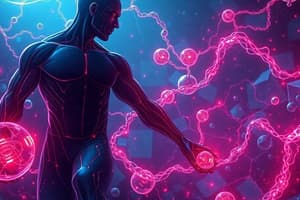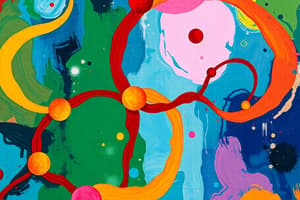Podcast
Questions and Answers
If a person's diet is deficient in an essential nutrient, what is the most likely outcome?
If a person's diet is deficient in an essential nutrient, what is the most likely outcome?
- The body will enter a state of hibernation to conserve the nutrient.
- The body's ability to perform certain metabolic processes will be impaired. (correct)
- The body will synthesize the nutrient to compensate for the deficiency.
- The body will increase absorption of other nutrients to make up for the deficiency.
Which statement accurately contrasts anabolism and catabolism?
Which statement accurately contrasts anabolism and catabolism?
- Anabolism releases energy by breaking down complex molecules, while catabolism consumes energy to synthesize complex molecules.
- Anabolism synthesizes complex molecules and consumes energy, whereas catabolism breaks down complex molecules and releases energy. (correct)
- Anabolism and catabolism both synthesize complex molecules, but anabolism releases energy while catabolism consumes it.
- Anabolism and catabolism both break down complex molecules, but anabolism consumes energy while catabolism releases it.
How do macronutrients primarily contribute to the body's functions?
How do macronutrients primarily contribute to the body's functions?
- By providing the building blocks for enzymes and hormones.
- By facilitating specific reactions and protecting cells from oxidative stress.
- By directly preventing disease and promoting rapid growth.
- By supplying the bulk energy required for metabolic processes. (correct)
What is a key difference between saturated and unsaturated fatty acids at room temperature?
What is a key difference between saturated and unsaturated fatty acids at room temperature?
How does the body primarily use essential amino acids obtained through the diet?
How does the body primarily use essential amino acids obtained through the diet?
What is the primary role of B-complex vitamins in the body?
What is the primary role of B-complex vitamins in the body?
Which of the following correctly matches a fat-soluble vitamin with its function?
Which of the following correctly matches a fat-soluble vitamin with its function?
How does the body utilize water-soluble vitamins differently compared to fat-soluble vitamins?
How does the body utilize water-soluble vitamins differently compared to fat-soluble vitamins?
Which mineral plays a critical role in both oxygen transport and the electron transport system?
Which mineral plays a critical role in both oxygen transport and the electron transport system?
What is the primary function of sodium and potassium in maintaining cellular physiology?
What is the primary function of sodium and potassium in maintaining cellular physiology?
During the absorptive state, which hormone is primarily responsible for increasing the uptake of glucose by liver and muscle cells?
During the absorptive state, which hormone is primarily responsible for increasing the uptake of glucose by liver and muscle cells?
What metabolic process does glucagon stimulate in the liver during the postabsorptive state to increase blood glucose levels?
What metabolic process does glucagon stimulate in the liver during the postabsorptive state to increase blood glucose levels?
How does the liver respond to decreased cholesterol levels in the blood?
How does the liver respond to decreased cholesterol levels in the blood?
What is the primary function of VLDLs (very-low-density lipoproteins)?
What is the primary function of VLDLs (very-low-density lipoproteins)?
Which lipoprotein is responsible for transporting lipids from the arterial wall to the liver for disposal?
Which lipoprotein is responsible for transporting lipids from the arterial wall to the liver for disposal?
What is the initial step in the process of hepatocytes using amino acids to generate ATP?
What is the initial step in the process of hepatocytes using amino acids to generate ATP?
What is the primary function of nutrient interconversion in the body?
What is the primary function of nutrient interconversion in the body?
Which of the following is a result of high levels of LDLs (low-density lipoproteins) in the blood?
Which of the following is a result of high levels of LDLs (low-density lipoproteins) in the blood?
What is the correct order of the four stages of cellular respiration?
What is the correct order of the four stages of cellular respiration?
During glycolysis, if there is an insufficient amount of oxygen available, what is pyruvate converted into?
During glycolysis, if there is an insufficient amount of oxygen available, what is pyruvate converted into?
Which process is stimulated by insulin during the absorptive state in adipose tissue?
Which process is stimulated by insulin during the absorptive state in adipose tissue?
Which metabolic process occurs in the liver to breakdown glycogen into glucose during the postabsorptive state?
Which metabolic process occurs in the liver to breakdown glycogen into glucose during the postabsorptive state?
Which of the following essential amino acids is abbreviated with the letter 'H'?
Which of the following essential amino acids is abbreviated with the letter 'H'?
A diet rich in what kind of fat encourages higher levels of LDL cholesterol?
A diet rich in what kind of fat encourages higher levels of LDL cholesterol?
If the body cannot synthesize a certain vitamin, how must a person obtain it?
If the body cannot synthesize a certain vitamin, how must a person obtain it?
Which of the following lipids is a precursor for steroid hormone, bile salts, and vitamin D?
Which of the following lipids is a precursor for steroid hormone, bile salts, and vitamin D?
What is a possible consequence of vitamin C deficiency?
What is a possible consequence of vitamin C deficiency?
How do you classify a vitamin you must acquire by eating certain foods or supplements?
How do you classify a vitamin you must acquire by eating certain foods or supplements?
Excess fat-soluble vitamins are stored in the body. What is the consequence of this property?
Excess fat-soluble vitamins are stored in the body. What is the consequence of this property?
Which feature characterizes incomplete proteins?
Which feature characterizes incomplete proteins?
Which of the following is the role of emulsifiers?
Which of the following is the role of emulsifiers?
Excess amounts of what mineral causes a goiter?
Excess amounts of what mineral causes a goiter?
Aside from adipose tissue, where else does the body circulate triglycerides?
Aside from adipose tissue, where else does the body circulate triglycerides?
Flashcards
What is Nutrition?
What is Nutrition?
The study of how living organisms obtain and utilize nutrients needed to grow and sustain life.
What are Nutrients?
What are Nutrients?
Biomolecules, vitamins, and minerals required for synthesis, energy, maintenance, growth and repair, obtained through food.
What is Metabolism?
What is Metabolism?
The chemical processes occurring within a living organism to maintain life.
What is Anabolism?
What is Anabolism?
Signup and view all the flashcards
What is Catabolism?
What is Catabolism?
Signup and view all the flashcards
What are Macronutrients?
What are Macronutrients?
Signup and view all the flashcards
What are Micronutrients?
What are Micronutrients?
Signup and view all the flashcards
What are Carbohydrates?
What are Carbohydrates?
Signup and view all the flashcards
What are Lipids?
What are Lipids?
Signup and view all the flashcards
What are Saturated Fatty Acids?
What are Saturated Fatty Acids?
Signup and view all the flashcards
What are Unsaturated Fatty Acids?
What are Unsaturated Fatty Acids?
Signup and view all the flashcards
What are Polyunsaturated Fatty Acids?
What are Polyunsaturated Fatty Acids?
Signup and view all the flashcards
What are Proteins?
What are Proteins?
Signup and view all the flashcards
What are Complete Proteins?
What are Complete Proteins?
Signup and view all the flashcards
What are Incomplete Proteins?
What are Incomplete Proteins?
Signup and view all the flashcards
What are Vitamins?
What are Vitamins?
Signup and view all the flashcards
What are Water Soluble Vitamins?
What are Water Soluble Vitamins?
Signup and view all the flashcards
What are Fat-Soluble Vitamins?
What are Fat-Soluble Vitamins?
Signup and view all the flashcards
What is Calcium?
What is Calcium?
Signup and view all the flashcards
What is sodium and potassium?
What is sodium and potassium?
Signup and view all the flashcards
What is Iodine?
What is Iodine?
Signup and view all the flashcards
What is Zinc?
What is Zinc?
Signup and view all the flashcards
What is Absorptive State?
What is Absorptive State?
Signup and view all the flashcards
What does Insulin do?
What does Insulin do?
Signup and view all the flashcards
What is Postabsorptive State?
What is Postabsorptive State?
Signup and view all the flashcards
What does Glucagon do?
What does Glucagon do?
Signup and view all the flashcards
What is Cholesterol Synthesis?
What is Cholesterol Synthesis?
Signup and view all the flashcards
What are Lipoproteins?
What are Lipoproteins?
Signup and view all the flashcards
What are VLDLs?
What are VLDLs?
Signup and view all the flashcards
What are LDLs?
What are LDLs?
Signup and view all the flashcards
What are HDLs?
What are HDLs?
Signup and view all the flashcards
What are Liver Functions?
What are Liver Functions?
Signup and view all the flashcards
What is Glycolysis?
What is Glycolysis?
Signup and view all the flashcards
What is the Citric Acid Cycle?
What is the Citric Acid Cycle?
Signup and view all the flashcards
What can Triglycerides Be Used for?
What can Triglycerides Be Used for?
Signup and view all the flashcards
Study Notes
- Nutrition is the study of how living organisms obtain and utilize nutrients needed for growth and to sustain life.
- Nutrients consist of most bimolecules, vitamins, and minerals.
- Nutrients are required for the synthesis of new molecules, energy production, for maintenance, growth, and repair.
- Nutrients obtained through food, e.g. water.
- Nutrient levels are regulated during and following meals
Anabolism
- The synthesis of complex molecules in living organisms from simpler ones; constructive metabolism.
- Requires energy
Catabolism
- The breakdown of complex molecules in living organisms to form simpler ones; destructive metabolism.
- Releases energy
Macronutrients vs. Micronutrients
- Macronutrients are nutrients required in large amounts whereas micronutrients are nutrients needed in small amounts
- Examples of macronutrients: protein, fat, fiber, water, and carbohydrate.
- Rich in macronutrients: cereals, legumes, meat, fish, yams, potatoes, nuts, and oil seeds
- Examples of micronutrients: phytochemicals and antioxidants, vitamins, and certain minerals
- Rich in micronutrients: vegetables, fruits, eggs, green leafy vegetables, and fermented foods.
- While macronutrients contribute to bulk energy needed for the metabolic system, micronutrients help various body functions, growth, and disease prevention
Carbohydrates
- Structurally classified as monosaccharides (e.g., glucose, fructose, galactose), disaccharides (e.g., sucrose, lactose, maltose) or polysaccharides (e.g., starches and fibers)
- In terms of dietary sources, carbohydrates are classified as sugars (monosaccharides, disaccharides, dextrose, brown sugar, honey, molasses), starch (e.g., tubers, grains, beans), and fiber, consisting of fibrous molecules from plants and animals, unabsorbed by the GI.
Lipids
- These include triglycerides, sterols (cholesterol), phospholipids, and eicosanoids
- Triglycerides composed of glycerol and are divided into saturated, unsaturated, or polyunsaturated.
- Sterols required as component of plasma membrane as well as a precursor hormone for steroid hormones, bile salts, vitamin D
- Sterols comes from diet or metabolic pathway in liver
- Phospholipids make up the cell membrane and have hydrophilic head and hydrophobic tails x2
- Eicosanoids are signaling molecules like Prostaglandins, Leukotrienes, and Thromboxanes
Saturated fatty acids
- Sources are solid at room temperature
- Dietary sources: fat in meat, milk, cheese, coconut oil, palm oil
Unsaturated fatty acids
- Sources are liquid at room temperature
- Dietary sources: nuts, certain oils—canola oil, olive oil, sunflower
Polyunsaturated fatty acids
- Contain two or more double bonds, that are liquid at room temperature
- Dietary sources are certain oils—soybean oil, corn oil, and safflower oil
Proteins
- They are the most structurally and functionally diverse molecules
- Needed in adequate quantities to replace worn out protein structures.
- Nine amino acids are essential, while the body can synthesize 11.
- These amino acids are used to synthesize new proteins in the body
Complete proteins
- Contain all essential amino acids
- Animal proteins
Incomplete proteins
- Do not contain all essential amino acids
- Plant proteins
- Essential amino acids can be provided by combining dishes containing plant protein.
Vegetarian
- Consumption of meat, poultry, and fish is avoided
- Lacto-ovo vegetarians do not eat animal flesh, but consume milk, eggs, and cheese
- Vegans do not eat any animal products, and must get essential amino acids through complementary protein sources, and not necessarily at the same meal, but regularly.
Vitamins
- They are organic molecules required for normal metabolism, present in small quantities in food and drink.
- Do not provide any energy (calories), but play roles in metabolic processes.
- Vitamins are categorized as water-soluble (vitamin B complex and vitamin C) or fat-soluble
- Essential and non-essential are also a categorization method
- Sourced from meat, eggs, beans, legumes, fruit, vegetables, and fish
- Water-soluble vitamins (B-complex and vitamin C) readily absorbed in bloodstream via digestive tract, and excess is secreted.
- Fat-soluble vitamins (A, D, E & K) absorbed with lipid micelles, and excess stored in fat cells
Functions of fat-soluble vitamins
- Vitamin A: pre-curser for the formation of the visual pigment retinal
- Vitamin E: helps stabilize and prevent damage to cell membranes
- Vitamin K: required for the synthesis of specific blood-clotting proteins
- Vitamin D: Increases calcium absorption from the GI tract.
Minerals
- All minerals are essential and must be obtained in the diet
- Iron present in hemoglobin within erythrocytes, where it binds oxygen; also present in the mitochondria as part of the electron transport system, to bind electrons
- Calcium required to form and maintain the skeleton, muscle contraction, and exocytosis of neurotransmitters; also plays an important role in blood clotting
- Sodium and Potassium function is to maintain a resting membrane potential in excitable cells and are also needed to propagate an action potential
- Iodine is required to produce thyroid hormone
- Zinc plays an important role in protein synthesis and wound healing
Absorptive State
- Time spent eating, digesting, and absorbing nutrients
- Lasts four hours after a meal
- Concentrations of glucose, triglycerides, and amino acids increase as absorbed from intestines
Insulin
- Major regulatory hormone released during absorptive state in the pancreas
- Released in response to increased blood glucose levels, which stimulates liver and muscle cells
- Enhances uptake of triglycerides from blood, stimulates lipogenesis, and stimulates most cells to increase amino acid uptake
- Forms glycogen from glucose and inhibits lipolysis, causing accelerated protein synthesis from the GI tract.
Postabsorptive State
- The time between meals
- Body relying on stores of nutrients and works to maintain homeostatic levels of nutrients via glucagon
- Major regulatory hormone during postabsorptive state
- Released in response to decreasing blood glucose levels
- It stimulates liver to increase breakdown of glycogen to glucose, Gluconeogenesis is stimulated from noncarbohydrate sources, and breakdown of triglycerides from adipose tissue
- Postabsorptive State has no effect on amino acids or proteins in cells
Liver and Cholesterol Synthesis
- Process achieved via hepatocytes, with fatty acids transported in blood, with Cholesterol produced at a basal level, and varies among individuals
- Cholesterol synthesis decreased with higher cholesterol intake, and vice versa
Forms of Cholesterol Release
- Released into blood in very-low-density lipoproteins
- Synthesized into bile salts (90% these reabsorbed moving through ileum versus 10% lost in feces, bile bound to fiber)
Lipoproteins
- Lipids with protein to facilitate transport, formed in liver, and classified by relative density
- Very-low-density lipoproteins (VLDL) have the most lipid
- Low-density lipoproteins (LDL) have less lipid
- High-density lipoproteins (HDL) have the least amount of lipid
Transport from Liver (VLDLs and LDLs)
- VLDLs have types of lipids with protein, assembled in the liver, and released into blood.
- VLDLs circulate in blood and release triglycerides to peripheral tissues, primarily adipose tissue
- LDLs contain high amounts of cholesterol, deliver cholesterol to cells, and bind to LDL receptors in the plasma membrane of cell (engulfed by endocytosis)
- The cholesterol is subsequently incorporated into plasma membrane and used by certain tissues to produce steroid hormones
Transport from Peripheral Tissues to the Liver
- It involves HDLs with proteins sent into blood without any lipids
- It circulates through blood and fill with lipids from peripheral tissue.
- Like LDLs, HDLs make cholesterol available to steroid-producing tissue.
- Unlike LDLs, HDLs are not engulfed, and lipids are transported via HDLs to liver.
- Excess cholesterol is converted into bile salts within the liver
Liver functions
- Carbohydrate metabolism involving gluconeogenesis, glycogen formation and breakdown, fructose and galactose converted to glucose
- Protein metabolism: Amino acids used to make proteins, urea elimination, and the conversion of amino acids
- Lipid metabolism involving formation and breakdown of triglycerides, cholesterol Synthesis, ketone bodies formation
- Transport of lipids via VLDL, LDL, and HDL
- Other factors include storage and drug detoxification
Clinical blood cholesterol levels
- Risk factors for cardiovascular disease: High levels of LDLs or total cholesterol, and low blood levels of HDLs
- LDLs are referred to as "bad" cholesterol because excess cholesterol deposits on inner arterial walls
- HDLs are referred to as ""good” cholesterol” and it transports lipid from arterial wall to liver
ATP cellular respiration
- Glycolysis: Anaerobic metabolic pathway in the cytoplasm to oxidize glucose to 2 pyruvate molecules, forming 2 ATP and 2 NADH from NAD+
- Pyruvate turns to lactate if oxygen is scarce
- Intermediate stage: Pyruvate is converted to Acetyl CoA, CO2 formed and NADH
- Acetyl CoA forms citric acid and then CO2, ATP, FADH2, and NADH are created in cycle
- Electron transport: Transfer of hydrogen and electron from NADH and FADH2, where Oxidative phosphorylation produces ATP
Lipid and protein metabolism alternate sources of ATP
- Protein-derived ATP via amino acid-derived ATP (removal of amine group via deamination in liver hepatocytes
- Amine group converts to urea for kidney removal
- Remainder of proteins then enters a metabolic pathway dependant on specific amino acid, which can then lead to glycolysis, intermediate stage, or citric acid cycle
Sources of ATP from triglyceride digestion
- Produces glycerol and fatty acids where glycerol can be converted to glucose for ATP production in cell metabolism
- Fatty acids can be oxidized and enter Krebs cycle to produce ATP
Nutrient interconversion
- Changing of one nutrient biomolecule into another
- Due to biochemical pathways associated with cellular respiration
- Example, glucose broken down to acetyl CoA, which then synthesized into triglycerides and stored instead of entering citric acid cycle
- Additionally, example where a low-carbohydrate diet of protein and fat can lead to a reversal of biochemical pathways of cellular respiration, converted to glucose.
Studying That Suits You
Use AI to generate personalized quizzes and flashcards to suit your learning preferences.




